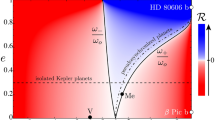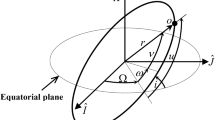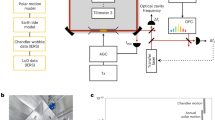Abstract
DESPITE the fact that the observation of an artificial satellite can be carried out only on a small region of the Earth's surface, we can use these measurements for determining the geocentrical co-ordinates of the satellite, if we know the approximate value of its distance from the Earth's centre. The most suitable observations are those in the neighbourhood of the zenith. If we know the inclination of the orbit, we can then determine also the position of the orbital node.
This is a preview of subscription content, access via your institution
Access options
Subscribe to this journal
Receive 51 print issues and online access
$199.00 per year
only $3.90 per issue
Buy this article
- Purchase on Springer Link
- Instant access to full article PDF
Prices may be subject to local taxes which are calculated during checkout
Similar content being viewed by others
References
King-Hele, D. G., Nature, 181, 738 (1958).
Smithsonian Astrophys. Obs. Circulars (Cambridge, U.S.A.).
Author information
Authors and Affiliations
Rights and permissions
About this article
Cite this article
BUCHAR, E. Motion of the Nodal Line of the Second Russian Earth Satellite (1957β) and Flattening of the Earth. Nature 182, 198–199 (1958). https://doi.org/10.1038/182198b0
Issue Date:
DOI: https://doi.org/10.1038/182198b0
This article is cited by
-
Satellite Gravimetry: A Review of Its Realization
Surveys in Geophysics (2021)
-
Earth’s gravity from space
Rendiconti Lincei. Scienze Fisiche e Naturali (2020)
-
The Earth gravity field in the time of satellites
Rendiconti Lincei (2015)
Comments
By submitting a comment you agree to abide by our Terms and Community Guidelines. If you find something abusive or that does not comply with our terms or guidelines please flag it as inappropriate.



